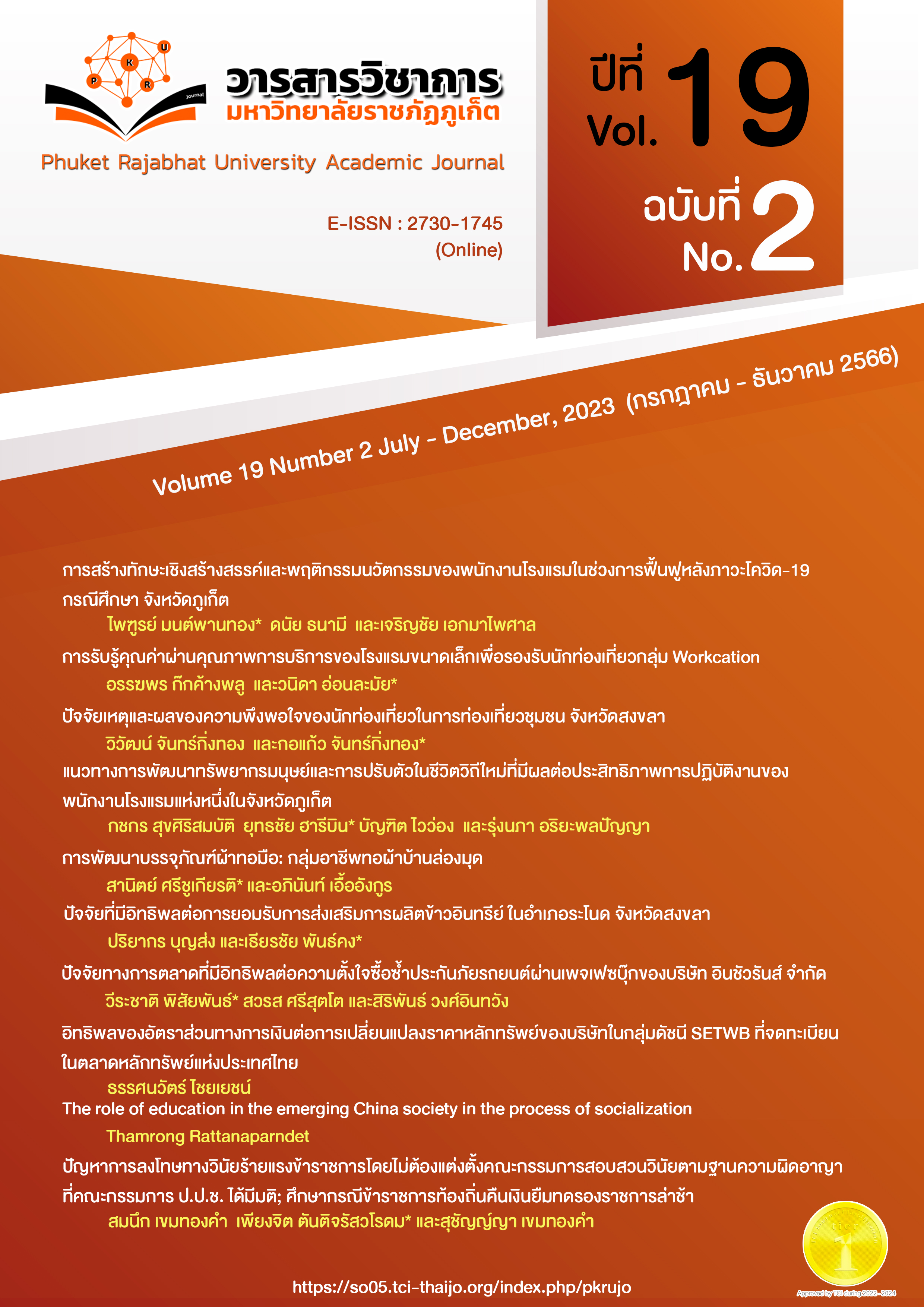ปัจจัยเหตุและผลของความพึงพอใจของนักท่องเที่ยวในการท่องเที่ยวชุมชน จังหวัดสงขลา
Main Article Content
บทคัดย่อ
การวิจัยครั้งนี้มีวัตถุประสงค์เพื่อตรวจสอบปัจจัยเหตุและผลของความพึงพอใจของนักท่องเที่ยว ในการท่องเที่ยวชุมชนจังหวัดสงขลา กลุ่มตัวอย่าง คือ นักท่องเที่ยวชาวไทยที่เข้ามาท่องเที่ยวชุมชนจังหวัดสงขลา จำนวน 400 คน ซึ่งเลือกมาโดยใช้การเลือกตัวอย่างแบบบังเอิญ การศึกษานี้เป็นการนำเสนอตัวแบบของความพึงพอใจของนักท่องเที่ยว และตรวจสอบปัจจัยเหตุและผลของความพึงพอใจของนักท่องเที่ยว ได้แก่ ภาพลักษณ์การท่องเที่ยว ประสบการณ์จากการท่องเที่ยว คุณค่าที่ได้รับจากการท่องเที่ยว ความไว้วางใจของนักท่องเที่ยว และความภักดีของนักท่องเที่ยว ผลจากตัวแบบสมการโครงสร้าง พบว่า ปัจจัยเหตุของความพึงพอใจของนักท่องเที่ยว ได้แก่ ภาพลักษณ์การท่องเที่ยว ประสบการณ์จากการท่องเที่ยว และคุณค่าที่ได้รับจากการท่องเที่ยว ในขณะที่ปัจจัยผลของความพึงพอใจของนักท่องเที่ยว ได้แก่ ความไว้วางใจของนักท่องเที่ยว และความภักดีของนักท่องเที่ยว
Article Details

อนุญาตภายใต้เงื่อนไข Creative Commons Attribution-NonCommercial-NoDerivatives 4.0 International License.
เนื้อหาและข้อมูลในบทความที่ลงตีพิมพ์ในวารสารวิชาการมหาวิทยาลัยราชภัฏภูเก็ต ถือเป็นข้อคิดเห็นและความรับผิดชอบของผู้เขียนบทความโดยตรง ซึ่งกองบรรณาธิการวารสารฯ ไม่จำเป็นต้องเห็นด้วยหรือร่วมรับผิดชอบใด ๆ
บทความ ข้อมูล เนื้อหา รูปภาพ ฯลฯ ที่ได้รับการตีพิมพ์ในวารสารวิชาการมหาวิทยาลัยราชภัฏภูเก็ต ถือเป็นลิขสิทธิ์ของวารสารวิชาการมหาวิทยาลัยราชภัฏภูเก็ต หากบุคคลหรือหน่วยงานใดต้องการนำทั้งหมดหรือส่วนหนึ่งส่วนใดไปเผยแพร่ต่อหรือเพื่อกระทำการใด ๆ จะต้องได้รับอนุญาตเป็นลายลักษณ์อักษรจากวารสารวิชาการมหาวิทยาลัยราชภัฏภูเก็ตก่อนเท่านั้น
เอกสารอ้างอิง
Assaker, G., O’Connor, P., & El-Haddad, R. (2020). Examining an integrated model of green image, perceived quality, satisfaction, trust, and loyalty in upscale hotels. Journal of Hospitality Marketing & Management, 29(8), 934-955.
Baron, S., Harris, K., & Hilton, T. (2018). Services marketing: Text and cases (3rd ed.). Palgrave Macmillan.
Chitthanom, C. (2020). Relationships among medical activity perceived functional values, satisfaction trust, and revisit intention in medical tourism: A case study on CLMV tourists in Thailand. ABAC Journal, 40(3), 54-77.
Chooset, N., Jankingthong, W., & Choochuay, P. (2021). The mediating role of satisfaction on customer relationship and loyalty: A case study of hotels’ service in Songkhla. Hatyai Academic Journal, 19(1), 93-111.
Cochran, W. G. (1977). Sampling techniques (3rd ed.). Wiley.
Cristobal-Fransi, E., Daries, N., Ferrer-Rosell, B., Marine-Roig, E., & Martin-Fuentes, E. (2020). Sustainable tourism marketing. MDPI. Retrieved August 24th, 2022, from https://doi.org/ 10.3390/books978-3-03928-683-6
Cronbach, L. J. (1990). Essentials of psychological testing (5th ed.). Harper & Row.
Fishbein, M., & Ajzen, I. (2010). Predicting and changing behavior: The reasoned action approach. Psychology Press.
Godovykh, M. (2022). Measuring affective components of customer experience: Conceptual and methodological issues. In D. Jaziri & R. A. Rather (Eds.), Contemporary approaches studying customer experience in tourism research (pp. 89-105). Emerald Publishing.
Hair, J. F., Black, W. C., Babin, B. J., & Anderson, R. E. (2014). Multivariate data analysis (7th ed.). Pearson Education.
Illescas-Manzano, M., Martínez-Puertas, S., & Sánchez-Pérez, M. (2022). The power of price and quality to explain customer satisfaction through spatial analysis. In D. Jaziri & R. A. Rather (Eds.), Contemporary approaches studying customer experience in tourism research (pp. 245-265). Retrieved August 24th, 2022, from https://www.emerald.com/ insight/publication/doi/10.1108/9781801176323
Kline, R. B. (2016). Principles and practice of structural equation modeling (4th ed.). Guilford Press.
Le, H. B. H., & Le, T. B. (2020). Impact of destination image and satisfaction on tourist loyalty: Mountain destinations in Thanh Hoa province, Vietnam. The Journal of Asian Finance, Economics and Business, 7(4), 185-195.
López-Sanz, J. M., Penelas-Leguía, A., Gutiérrez-Rodríguez, P., & Cuesta-Valiño, P. (2021). Sustainable development and consumer behavior in rural tourism-the importance of image and loyalty for host communities. Sustainability, 13(9), 4763.
Martini, U., & Buffa, F. (Eds.). (2020). Marketing for sustainable tourism. MDPI. Retrieved August 24th, 2022, from https://doi.org/10.3390/books978-3-03928-874-8
Nunkoo, R., & Gursoy, D. (2016). Rethinking the role of power and trust in tourism planning. Journal of Hospitality Marketing & Management, 25(4), 512-522.
Othman, B., & Harun, A. B. (2021). The influence of service marketing mix and umrah service quality on customer satisfaction and customer loyalty towards umrah travel agents in Malaysia. Technium Social Sciences Journal, 22, 553–618.
Paliszkiewicz, J. (Ed.). (2020). Knowledge management, trust and communication in the era of social media. MDPI. Retrieved August 26th, 2022, from https://dlib.phenikaa-uni.edu. vn/handle/PNK/6490
Perri 6, & Bellamy, C. (2012). Principles of methodology: Research design in social science. SAGE.
Robinson, S., & Etherington, L. (2006). Customer loyalty: A guide for time travelers. Palgrave Macmillan.
Rodríguez-Díaz, M., & Espino-Rodríguez, T. F. (2019). Tourism destination management. MDPI.
Scherf, K. (2021). Creative tourism in smaller communities: Place, culture, and local representation. University of Calgary Press.
Schumacker, R. E., & Lomax, R. G. (2010). A beginner's guide to structural equation modeling (3rd ed.). Routledge.
Songkhla Provincial Office. (2022). Tourist information, Songkhla province. Retrieved July 14th, 2022, from https://www.songkhla.go.th/frontpage
Suhartanto, D., Brien, A., Primiana, I., Wibisono, N., & Triyuni, N. N. (2020). Tourist loyalty in creative tourism: The role of experience quality, value, satisfaction, and motivation. Current Issues in Tourism, 23(7), 867-879.
Suhartanto, D., Dean, D., Wibisono, N., Astor, Y., Muflih, M., Kartikasari, A., & Hardiyanto, N. (2021). Tourist experience in Halal tourism: What leads to loyalty? Current Issues in Tourism, 24(14), 1976-1990.
Swart, M. P. N. (2018). Providing service quality and customer care in tourism businesses. In M. Sotiriadis (Ed.), The emerald handbook of entrepreneurship in tourism, travel and hospitality (pp. 191-206). Retrieved August 26th, 2022, from https://www.emerald. com/insight/publication/doi/10.1108/9781787435292
Tangjaturasopon, A., Vongchavalitkul, B., & Sangsuwan, T. (2021). A cluster analysis of Thai tourists influencing loyalty towards northeastern tourism of Thailand. Hatyai Academic Journal, 19(2), 309-326.
Wang, H., Yang, Y., & He, W. (2022). Does value lead to loyalty? Exploring the important role of the tourist–destination relationship. Behavioral Sciences, 12(5), 136-149.


